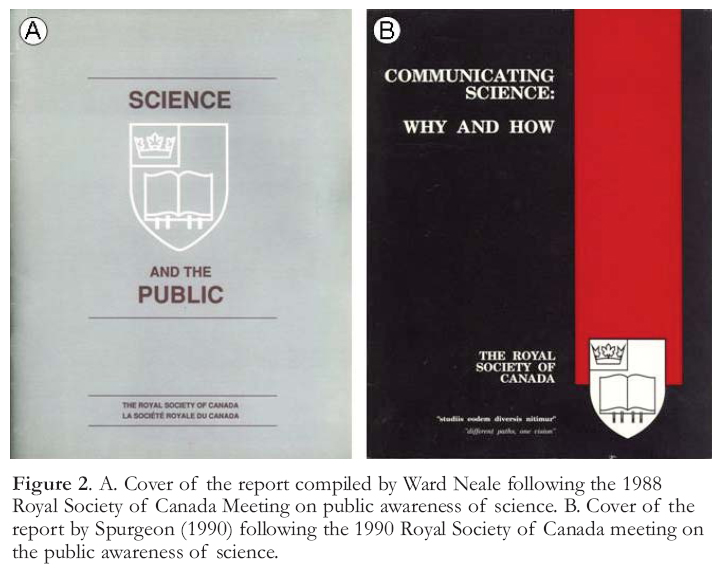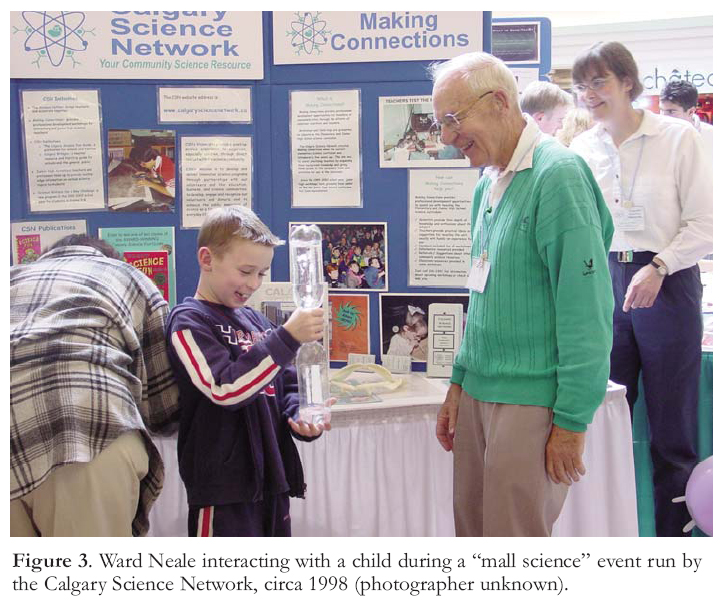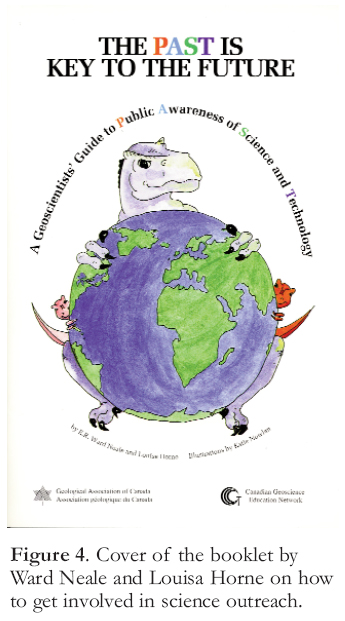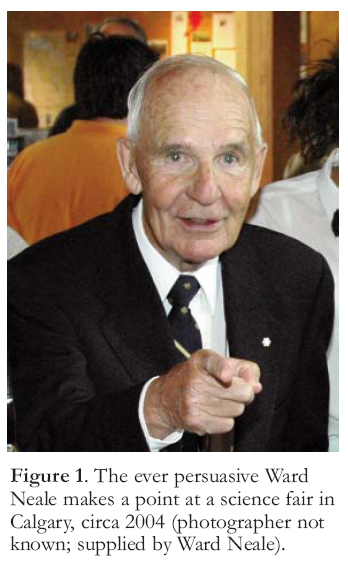Articles
The Contribution of Ward Neale to the Development of Scientific Outreach and Education in Canada
Godfrey S. NowlanGeological Survey of Canada, 3303 – 33rd Street N.W., Calgary, Alberta, T2L 2A7
gnowlan@nrcan.gc.ca
INTRODUCTION
1 Ernest Richard Ward Neale (1923-2008) was simply “Ward” to all those who knew him. He was a major contributor to the development and well being of the earth science community in Canada. He made contributions to research, especially in the Appalachian orogen, to earth-science education, scientific editing, earth-science societies (he served as President of GAC in 1972-73), and to science outreach. It is his contribution to this last item that is the subject of this brief article.
2 I am not sure when Ward first got fired up about the importance of science outreach in Canada, but I suspect it might have been when he read the article entitled, Geology in the Public Eye (Baird 1968) which was published in a Royal Society of Canada volume that he edited. The final sentence of that article read as follows: “Our professional societies should seriously appraise our public image, think about what should be done to improve it, and get busy”. Ward took this exhortation to heart and got to work as soon as he took up the position of Head of the Geology Department at Memorial University of Newfoundland (MUN) in 1968. In his early years at MUN he was well known because he did a series of 30 broadcasts for CBC Radio on earth science and another five on Newfoundland geology for the University of the Air series that ran on CTV.
3 I first met Ward in 1971 as an incoming graduate student to the Department of Geology at MUN, where Ward was still Head. He was very good at communicating messages to others and getting them to buy into his ideas and interests. I know that he had built a magnificent department in which the free, full and frank exchange of ideas was encouraged. Not only was the department a great place to be, but Ward had convinced the university administration that this was the best geology department in Canada. This ability to communicate his ideas and persuade and influence people was a key facet of his character that he applied to science outreach (Fig. 1).
4 Starting in 1975, he was also a major contributor to this journal in a column called Pyroclasts, which put forward, “news and comment on some of the peripheral matters of interest to Canadian geoscientists, for example, politics and politicians, sex, relations with sister societies, assorted scuttle-butt and rife humour” (Neale 1975). This column tackled many of the issues of the day and commonly provoked sharp responses, but it served to stir the pot and keep communication going among Canadian earth scientists on the issues of the day. He maintained this effort until the end of 1982, producing a total of 22 Pyroclasts columns.
Figure 1. The ever persuasive Ward Neale makes a point at a science fair in Calgary, circa 2004 (photographer not known; supplied by Ward Neale).THE CALGARY SCIENCE NETWORK
5 It was when Ward retired in 1987 from his position as Vice-President Academic of MUN and returned to Calgary that his efforts in the public awareness of science kicked into high gear. In Calgary he worked at both the local and national level to achieve multiple goals in promoting the public awareness of science. In 1988, the rudiments of the Calgary Science Network were coming to life in the form of a classroom visit program, and discussions on how to get a city-wide organization that embraced all of science established and funded. Ward was a key instigator and organizer of these activities. At the same time, he was working for the Royal Society of Canada (RSC), to organize a two-day conference of delegates of national scientific and engineering societies that was held in Ottawa on March 4 and 5, 1988 (Fig. 2A). The conference was based on the idea that “individual scientists can be motivated by their societies to view their work in its social context and to recognize their obligations to explain it to the public” (Neale 1988). This conference drew together 75 scientists from many different fields and was the first time that many of the representatives were exposed to the outreach activities of scientific and engineering societies in Canada. It served as a stimulant to the development of many new science outreach projects in Canada. Happily, it was also a time when federal programs were designed to increase Canada’s science and technology base. Some will remember fondly the Science Culture Canada Program that issued $5 million in grants under a peer adjudicated system. This was a time when there was federal money available for science outreach projects.
Figure 2. A. Cover of the report compiled by Ward Neale following the 1988 Royal Society of Canada Meeting on public awareness of science. B. Cover of the report by Spurgeon (1990) following the 1990 Royal Society of Canada meeting on the public awareness of science.

Display large image of Figure 2
6 A follow-up conference was organized for 1990 by Ward and others. In my recollection this was an even more stirring event, with about 90 scientists and engineers attending; it has been described in some detail by Spur-geon (1990; Fig. 2B). At about the same time, a major study of science literacy in Canada was published (Einsiedel 1990). Edna Einsiedel shared her results at the conference and made a very significant impact. Ward was particularly influenced by this piece of work and it formed the basis for his re-doubled efforts in the following years. In a quote attributed to Ward by Spurgeon (1990), he stated that “In the two years between conferences, many scientists seem to have realized the need to communicate with the public and are doing so either individually or in ad hoc groups”. He is quoted as pointing out that institutions and societies were slower to heed the call and slow to recognize the efforts of their staff and members. He concluded by saying that, “It appears the foot soldiers are setting the pace and the leaders must make an effort to catch up with their troops by recognizing changing times and the changing needs of their members and the public”.
7 These conferences inspired many projects in the public awareness of science across the land. Back home in Calgary, Ward was busy putting the final touches to the Calgary Science Network and it formally became a charitable society in 1991. It had been active in the early days of National Science and Technology Week (NSTW) in 1990, and NSTW was the cement that glued the organization together in the early days. As far as Ward was concerned this was a new paradigm: science outreach from the community’s grass roots. Over time he lost faith in the scientific societies that he tried to engage with the RSC conferences and turned to advocating a grassroots approach. The development of the Calgary Science Network in its first decade is well described by Nowlan and Neale (2000). Happily, it has successfully made the crucial transition as a non-profit organization to a board that contains none of its original founders. The organization is now part of a provincial organization, the Alberta Science Literacy Association, and it continues to send scientists to classrooms and to educate teachers through workshops provided jointly by scientists and teachers. Hundreds of thousands of Calgary-area school children have received a visit from a scientist dispatched by the Network (the total of 250 000 was passed in 2009) and nearly 5000 teachers from Calgary and the surrounding area have benefited from a workshop over the last ten years. The network continues to innovate and attract new volunteers, and last year it established a Volunteer Award in Ward’s name. I feel sure that CSN was one of Ward’s proudest achievements: he did a huge amount of the hard work required to establish such an organization and with typical humility, was proud to be the “first Past President” – he was never President. Over the years he worked tirelessly behind the scenes to attract new people, develop new programs and help sustain existing ones (Fig. 3). It was only when his hearing deteriorated late in his life that he stopped participating actively in the meetings of the network.
THE CANADIAN GEOSCIENCE EDUCATION NETWORK (CGEN)
8 Ward was also a participant in the conference organized by the Geological Society of America (GSA) from which sprang the Coalition for Earth Science Education (CESE) in 1993. This was held in February at the Johnson Foundation’s Wingspread Conference Centre in Racine, Wisconsin. Ward’s report from this meeting included a reference to Canada: he noted that, “we have done a few good things in geoscience education but they have been generally ad hoc and short-lived, the EdGEO program of the Canadian Geoscience Council is a partial exception. It is time to take a leaf out of the book opened by GSA and either join the coalition it is bringing together or form a separate Canadian coalition with links to that of our US colleagues”. This was a clear reference to the concept of the Canadian Geo-science Education Board, which held its first meeting in May 1993.
Figure 3. Ward Neale interacting with a child during a “mall science” event run by the Calgary Science Network, circa 1998 (photographer unknown).

Display large image of Figure 3

Display large image of Figure 4
9 Inspired by the Wingspread meeting and the model of CESE, Ward played a key role in the development of what was called the Canadian Geoscience Education Board. Again he cajoled people to get involved and he promoted the idea for what was to become one of Canada’s most successful groups in the public awareness of science. The inaugural meeting of this organization was held on Wednesday May 19, 1993, in Edmonton, in association with the GAC–MAC meeting held there. Again Ward was not the Chair – that honour fell to Laing Ferguson (then of Mount Allison University) – but Ward had played a strong role in advocating for the formation of the organization. The original composition of the Board was a representative from each earth science society, which was in line with Ward’s early thinking on the importance of societies. In late 1994, because of uneven participation from society representatives, it morphed into the Canadian Geoscience Education Network and invited all those interested in geo-science outreach to become members. The minutes stated that the word “Board” had an authoritarian ring to it and that the group, “decidedly wanted to be an activist grassroots organization”. Thus it followed the shift from society-based function to grassroots function that Ward so favoured.
10 One of Ward’s major contributions to the early efforts of CGEN was the publication of a booklet entitled A Geoscientists’ Guide to Public Awareness of Science and Technology (Fig. 4). This booklet was co-authored with Louisa Horne and co-published with the Geological Association of Canada (GAC) in May 1995. A free copy of this attractively illustrated booklet was provided to every registrant at the 1995 GAC–MAC meeting in Victoria. It provided helpful advice to anyone who was interested in getting involved in the public awareness of earth science.
11 CGEN now has more than 300 members and can honestly be said to be the most successful group at getting things done in earth science outreach in Canada. In its early days, it took EdGEO under its wing, and the chair of CGEN became the Outreach Director of Canadian Geoscience Council (CGC) and subsequently the Canadian Federation of Earth Sciences (CFES), thus giving the organization a great opportunity to maintain communication with the earth science community while at the same time reaching out to people all across Canada. It is interesting to note that the organizational trajectories of CGEN and CESE have turned out quite differently. The CESE represents a diverse group of organizations and individuals dedicated to addressing national concerns in Earth system education, and was instrumental in getting earth science incorporated into the National Science Education Standards in the United States, providing opportunity for nationwide implementation of earth science into school science curricula, although I think our US colleagues would agree that there has not been universal success with this approach. The CGEN took a more grassroots approach and at the recent (2009) Joint Assembly meeting held in Toronto, I heard several American out-reach people say that they needed the kind of network provided by CGEN. On the other side of the coin, CGEN is only now getting around to addressing earth science in curricula and it is using a rather different approach, i.e. encouraging the use of earth science examples in the social studies and science curricula.
AWARDS AND ACCOLADES
12 Ward was appointed to the Order of Canada on April 20, 1990. He was recognized as a scientist and university administrator, but one sentence from the citation also recognized his contribution to earth science outreach: “he has made a significant contribution to the public appreciation of science and to the international geoscience community”. This award meant a lot to Ward and I think he was particularly gratified that his contribution to outreach was recognized.
13 The Geological Association of Canada struck a medal in 1995 in Ward Neale’s honour (Fig. 5). The description of the qualities of a winner of the medal is as follows: “The award recognizes outstanding efforts to communicate and explain geoscience to the public through one or more of the following vehicles: public lectures, print or electronic media articles, school visits, elementary and secondary school educational materials, field trips, science fairs, and other public communications”. In fact the description of the E.R.W. Neale Medal cites him as “the legendary Ward Neale”, indicating the great respect and affection in which he was held by the membership of the GAC. I think, perhaps, this recognition even eclipsed the pleasure he felt upon receiving the Order of Canada and he made sure that he and his wife Roxie were at every award ceremony for this medal from 1995 to 2007, passing away just before the 2008 ceremony. He was always careful not to endorse any particular candidate for this award and was delighted every year to discover who would be the latest addition to the list of Neale medal winners.
CONCLUDING COMMENTS
14 Ward continued as an activist for the Calgary Science Network and other organizations throughout the late 1990s and into the twenty first century. He volunteered at all sorts of events, including science fairs, and was always part of the contingent that went to aboriginal science fairs in southern Alberta. In his later years, Ward became hard of hearing and was never satisfied with hearing aids, despite investing in a variety of devices. His inability to hear well drove him to abandon most meetings and thus separated him from the formal processes of many of the organizations for which he had worked so hard throughout his life.
Figure 5. The E.R.W. Neale Medal of the Geological Association of Canada (courtesy of GAC®).

Display large image of Figure 5
15 The last major earth science outreach meeting that he attended was the session and workshop held in conjunction with the 2007 GAC–MAC in Yellowknife, NWT. He was enormously pleased with the fact that the largest session at the meeting was the Out-reach session and that he was there when the E.R.W. Neale Medal for 2007 was awarded to Dixon Edwards. The outcomes from that meeting (Nowlan and Schreiner 2007) bore the stamp of Ward’s contributions.
16 Ward would be delighted with the new developments in the area of Geoheritage in Canada. The fact that there is an active national group under the leadership of Al Donaldson and a strong groundswell for the establishment of GeoParks in Canada would be music to Ward’s ears.
17 The contribution of Ward Neale to the development of modern science outreach programs in Canada is immense. He was behind the scenes of almost every major innovation in science outreach in Canada since the late 1980s. He was a constant gadfly, coaxing and cajoling fellow scientists to explain what they did in terms the public could understand. At the same time he was a walking job jar who persuaded many individuals to pull a job out of the jar and get working on it. His tremendous persistence, coupled with his innate charm, produced many of the current leaders in science out-reach in Canada, especially in the earth sciences. The fact that there are now 300 people in Canada pleased to receive regular notifications and news from the Canadian Geoscience Education Network is a testament to his energy and vitality, which never waned up to the day he died.
REFERENCES
Baird, D.M., 1968, Geology in the Public Eye, In The Earth Sciences in Canada: A Centennial Appraisal and Forecast, edited by E.R.W. Neale: The Royal Society of Canada, Special Publication No. 11, p. 222-230.
Einsiedel, E.F., 1990, Scientific Literacy – A Survey of Adult Canadians: Commincations Studies, University of Calgary, 50 p.
Neale, E.R.W. 1975, A Column: Geoscience Canada, v. 2, p. 220-221.
Neale, E.R.W., 1988, [Compiler] Science and the Public, Report on a conference of National Scientific and Engineering representatives: Royal Society of Canada, 23 p.
Neale, E.R.W., and Horne, L., 1995, The PAST is the Key to the Future: A Geoscientits’ Guide to Public Awareness of Science and Technology: Geological Association of Canada and the Canadian Geoscience Education Network, 28 p.
Nowlan, G.S., and Neale, E.R.W., 2000, Evolution of the Calgary Science Network: An unabashed tale of speciation, extinction and diversity: Geo-science Canada, v. 27, p. 23-30.
Nowlan, G.S., and Schreiner, D., 2007, The State of Earth Science Outreach in Canada and an Action Plan for the Future: Results of a Session and Workshop Held in Yellowknife, N.W.T., May 24-27, 2007: Geoscience Canada, v. 34: 49-54.
Spurgeon, D., 1990, Communicating Science: Why and How, Second conference on public awareness of science in Canada: Royal Society of Canada, 22 p.
